Chris Parkin falls in love with the performance, feel, engineering and design of the Steyr Mannlicher CLII SX Mountain in .223 in this rifle test and review...
I won’t deny that some of the Steyr rifles from just a decade ago used polymer stocks that I found somewhat disappointing, they were slim and weak through the forend with intermittent barrel contact affecting harmonics, but the new ilk, like the CLII, should not be confused with those in any respect. The barrel begins with a 15x1 thread machined into the 17.3mm overall muzzle diameter. The crown is recessed and smoothly finished with all threads still bright steel and easily accepting moderators right up to the shoulders meeting and nipping/staying tight.
The black external finish to the barrel shows characteristic barley twist contouring of the rotary hammer forging procedure which Steyr leave in place, offering a delightful visual hallmark many manufacturers machine away to leave a cylindrical tube. Maybe Steyr hammer more neatly and can get away with this without the need to smooth out the imperfections.
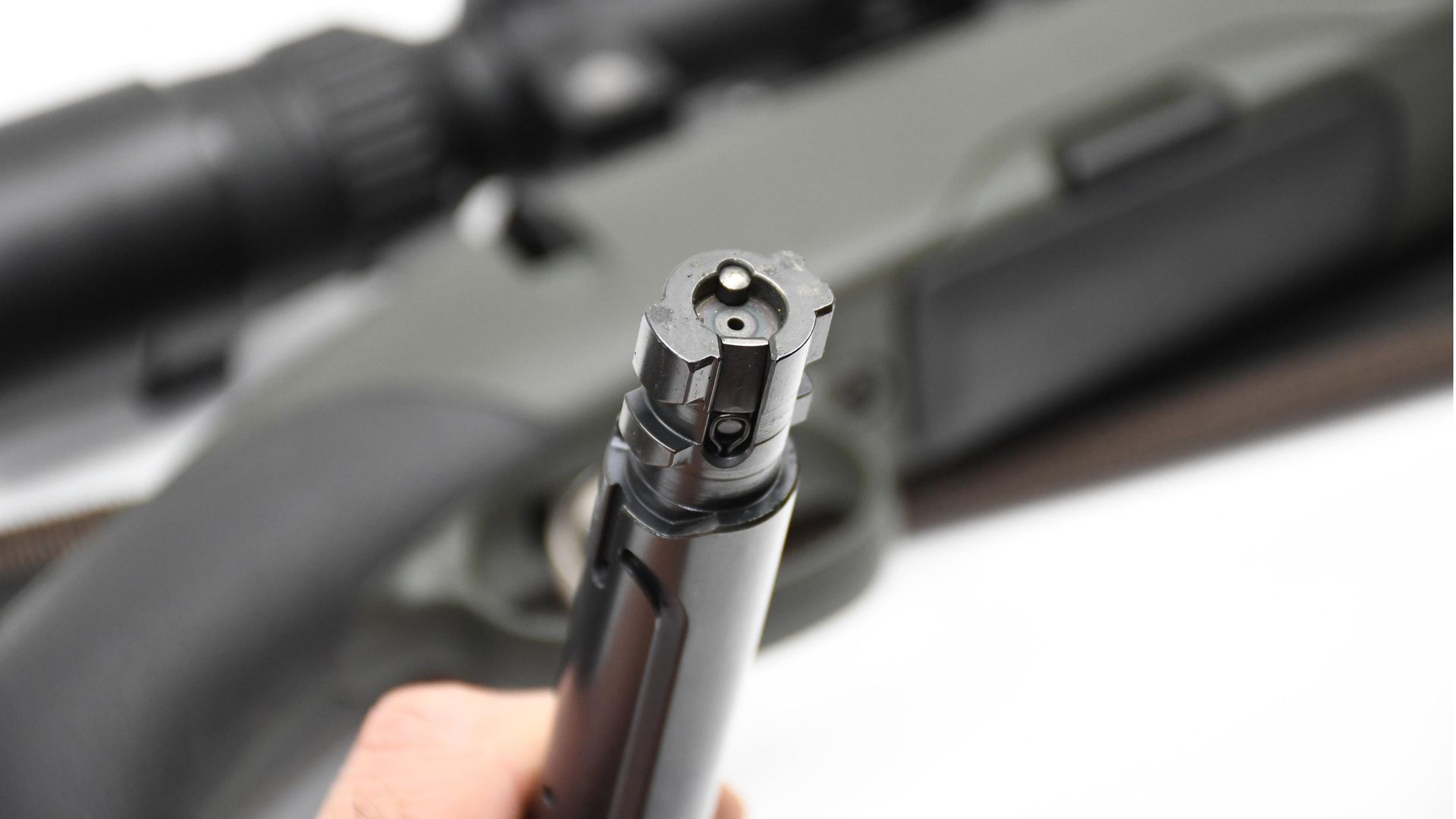 credit: Chris Parkin
credit: Chris Parkin
Overview
The barrel has swollen gently out to its reinforce becoming 29mm where it enters the receiver body. This overall cylindrical profile shows significant facets radiused at their edges to blend a triangular profile, somehow organically in a way, but a pleasing shape with impeccable metal finishing without a single blemish throughout the entire rifle.
Removed from the stock, you see a rectangular stepped recoil lug bolted to the underside, which itself mates to the 3-dimensional aluminium bedding block within the injection moulded polymer stock. This spans the front and rear action bridges, bridging the magazine well and ensures both action screws tension down hard without any stock compression.
Upon disassembly, I have never known action screws, especially the front, tensioned so hard. This came away cleanly but my torque wrench measured somewhere near 15 Nm, where I normally re-tension to around 5/6 Nm. There is no applied bedding stress, no movement from tensioned to lose, so I’m very happy with the system Steyr has used. I managed to fall over on the rifle at one point foxing and there was no damage or loss of zero from impact between me and the gravel which left me cut and bruised.
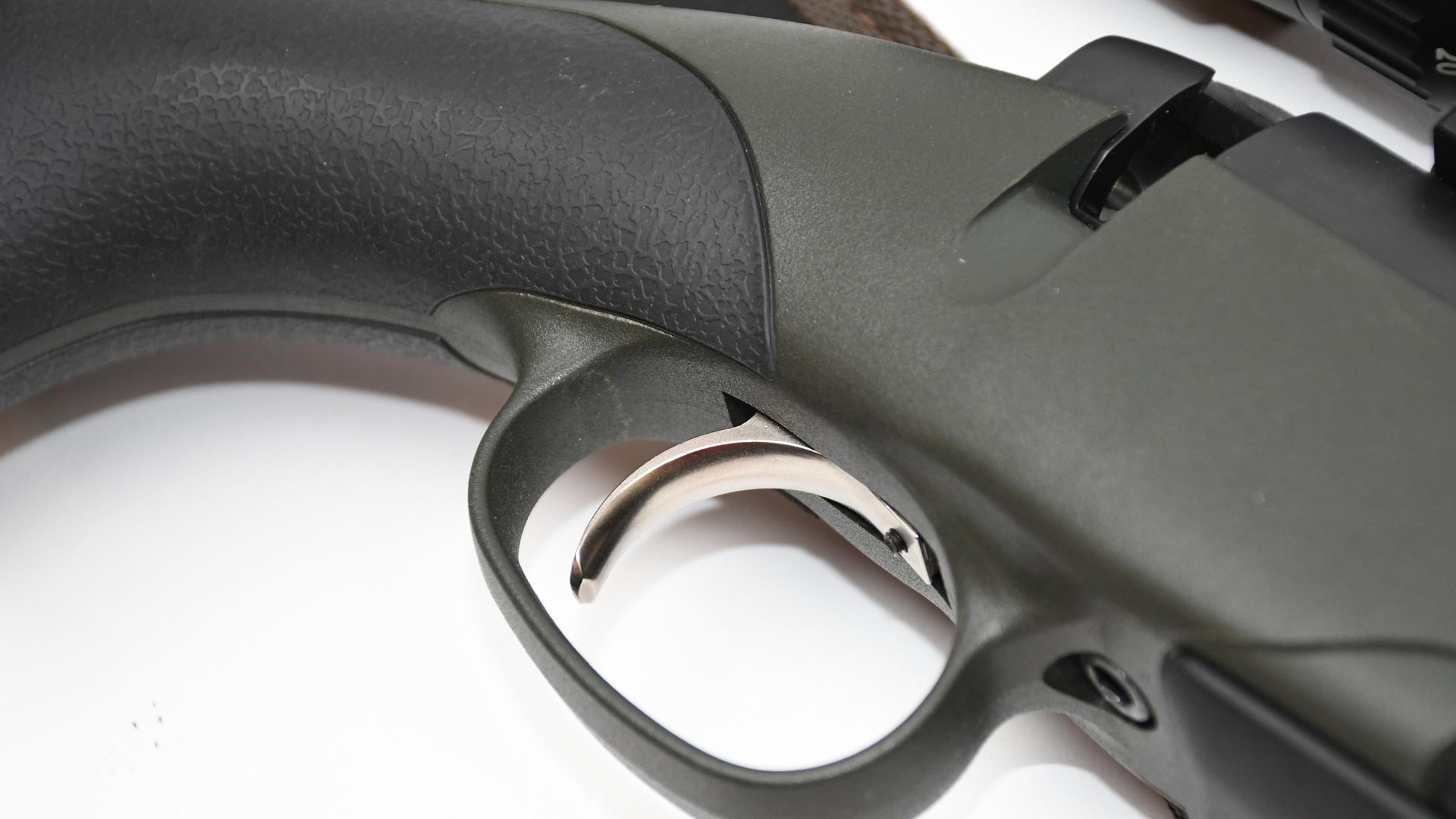 credit: Chris Parkin
credit: Chris Parkin
Scope mounting and trigger
Four screw holes are presented on the radiused action upper to accept scope mounts, either separate bases or a Picatinny rail. Everything is scaled appropriate to cartridge and the right-side ejection port is just 54.2mm long for this 223, leaving the maximum amount of steel in place for assured rigidity.
The underside mag cut-out at 66.8mm is a little longer for the larger polymer magazine surrounding 4 rounds presented towards the feed ramp/chamber in two columns. All edges are perfectly neat cut square or deliberately radiused, small details that reassure the rifle’s value at its price point. The trigger unit extends beyond the action tang rather than being hung beneath it. It is an incredibly complex unit in machined steel and polymer mouldings to incorporate both single stage regular pull or super light single set trigger, alongside the tang mounted safety catch roller.
This is an unusual catch design but rather than being different for the sake of it, shows intrinsic design features for which you begin to really `get` Steyr’s ethos. The integration of trigger and safety is more than just associated tools, they are mechanically entwined and interwoven! The bolt shows a 90-degree lift with two pairs of opposing lugs spanning the push feed face. There is a single plunger ejector opposing the ejection port on the lower left and a single extractor claw adjacent to the port on the upper right, even if the lugs are split into pairs, it’s still a 90-degree lift to unlock, cock and open the action.
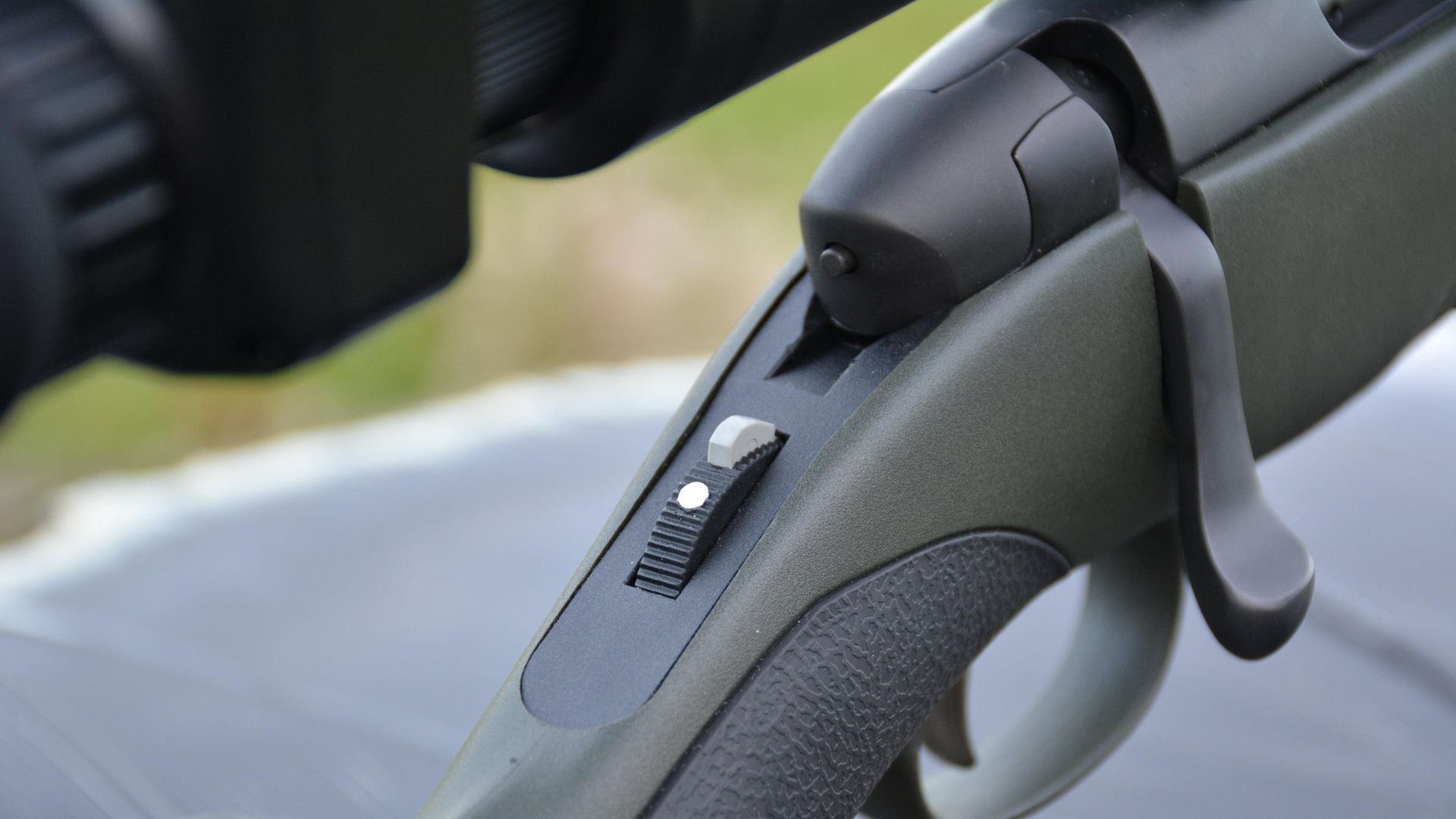 credit: Chris Parkin
credit: Chris Parkin
Bolt action
Bolt stroke is 93.9mm, again scaled to the smaller action and runs in either direction within the receiver without stuttering or any travel inhibition, just a single raceway in the bolt shaft for antirotating and bolt stop. So, to the safety. Well with the action cocked and breech loaded, a red dot is seen on the roller, informing ready to fire. If you ease the roller backward towards your thumb, this shows a white dot, with bolt operable, but safety applied. Roll it back another click and a pale grey button flips up to block all movement, this locks the bolt handle as well as having the action safe.
Well now you get the crowning glory, if you press down on the end of the 60mm bolt handle, it clicks down deeper within the stock recess and locks in close to the rifle’s side, a bit like `super closing` the bolt. This makes the handle less obtrusive and unlikely to snag anything or dig into you when walking, it also fully locks the bolt and firing pin, making the gun totally inoperable. All this sounds far more complex than it is but after the first couple of uses, you really start to appreciate it and the ability to lock the firing pin, not just `block the trigger from releasing it, is far more assured, like the wing safety on a Mauser M03, M12 or a de-cocker fitted to a Blaser or Merkel etc. that little extra step towards more assured safety.
To release the safe bolt system, press the light grey button silently as you roll the safety forward one stage or two and the handle lifts back into normal `closed` position, ready as normal. I kinda liked it, functional, safe and characterful, Steyr’s way! The trigger itself is another of Steyr’s classic and has a single set function. In normal use, the single stage pull, on the silver 8.8mm wide blade, offers crisp pull of 2090 grams or 4lb 10 oz. This is heavier than often seen elsewhere and the instruction book tells you not to tinker with it.
It is super crisp and amazingly consistent with sub 15gr variation but requires a patient squeeze, not one for the jerkers. Alternatively, the rear surface of the trigger is vertically serrated and if pushed forward, you enter single set mode which offers 130gr or 4.6oz, pull weight. A bit too light for my tastes, but some will love its super-fast mechanics.
Bolt removal shows the combined trigger/safety catch function, so with the action opened in either `fire` or `unlocked` position, lift the handle then flick the roller to fully `safe` mode, the bolt draws out as smoothly as a butterknife from a chunk or Lurpac, with no combined button press required.
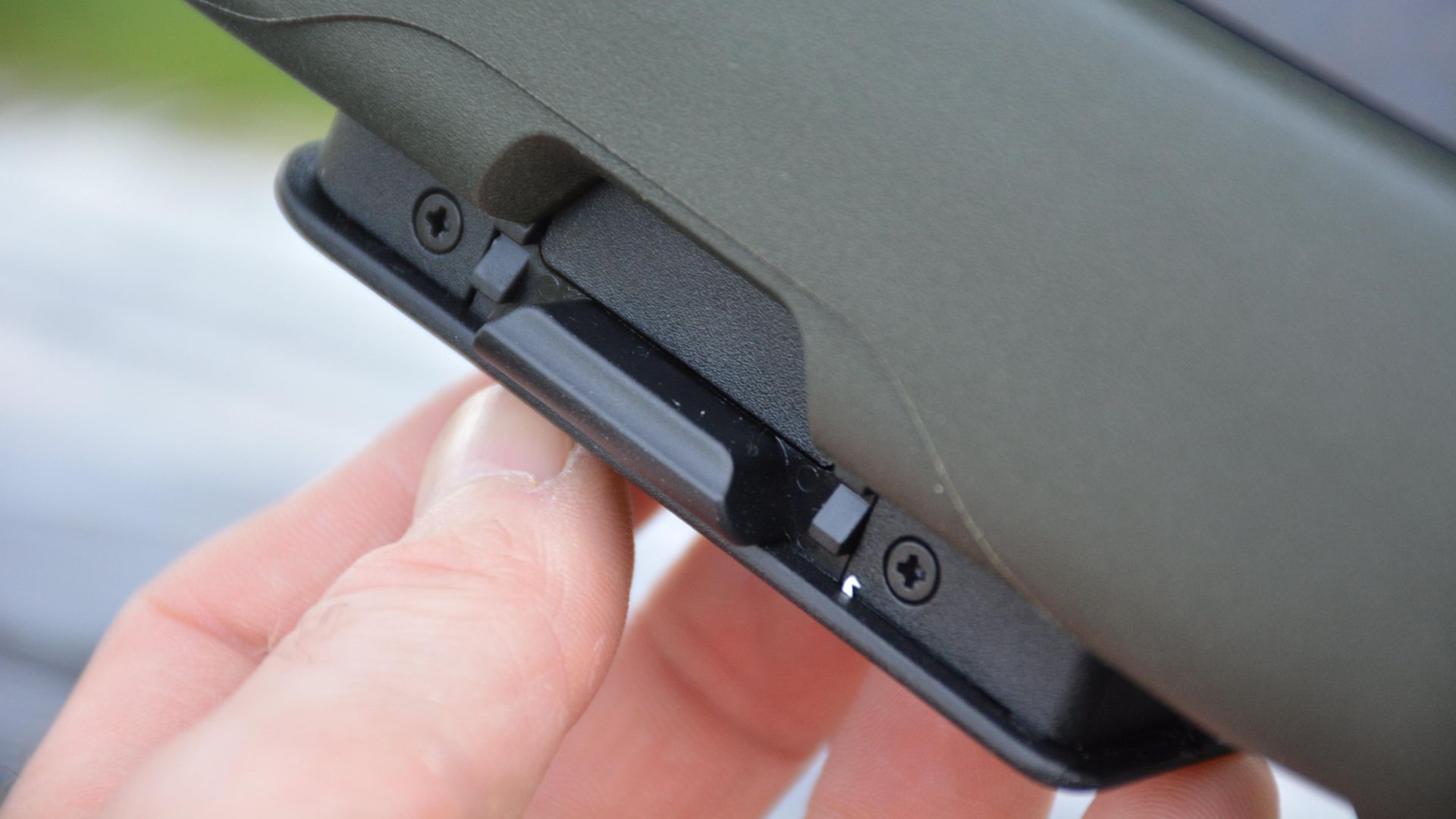 credit: Chris Parkin
credit: Chris Parkin
The magazine
Regarding the action, the final matter to discuss is the superb magazine system. The is a four-round unit (+1 in the chamber if needed with the safe bolt system) with ammo stacked side by side in two columns, very unusual for a .223 but attractive for several reasons. Number one is that the mag is short and compact, slotting easily into the underside well with twin release catches either side to simply squeeze and draw it out or reinsert with zero shuffling needed to access any latching mechanism.
Second, it will load with rounds pressed in straight from the top, so faster to fill up without looking at it. Thirdly, you can add single rounds while it’s still in the rifle, the ejection port is small but it’s still possible. The last factor is that a single round dropped on top of the empty mag/bare follower through the ejection port loads straight to the chamber for a backup shot, quite unusual for a .223 and very appealing.
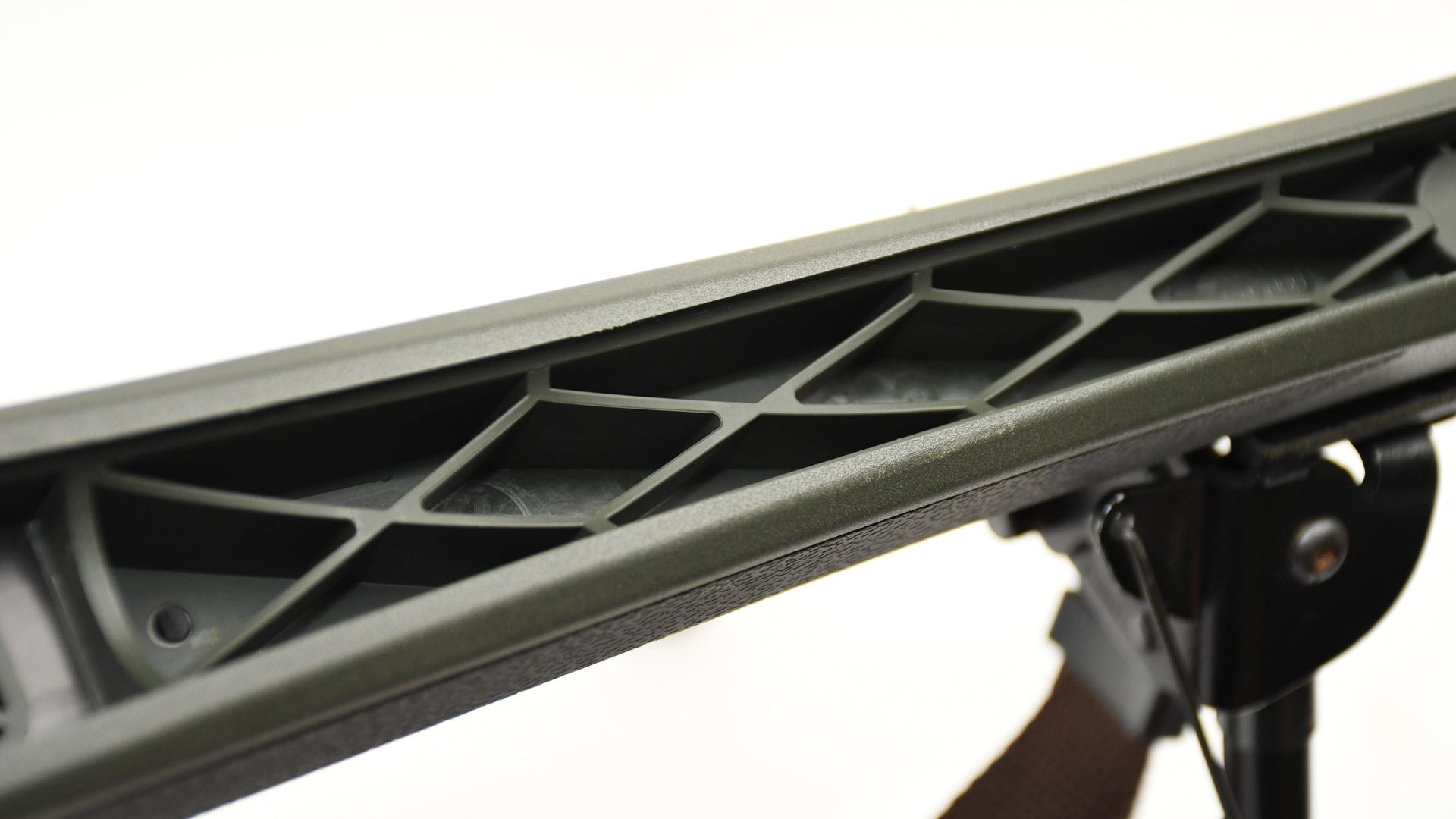 credit: Chris Parkin
credit: Chris Parkin
The stock
The stock is presented in a deep green injected moulded polymer but a step up from many. It shows a complex internal aluminium bedding block for the action already mentioned, but of equal, if not more importance, the slender forend is heavily ribbed for rigidity producing a totally trustworthy free-floating barrel from any shooting position, regardless of clumsiness, accidental or deliberate.
Both forend and grip feature moulded in soft touch rubberised grippy surface, contrasting in black to break up the rifle’s silhouette. A minimal ambidextrous palm swell and a slender comb flow on terminating at the butt’s solid, medium/firm texture recoil pad which at 18mm thick, which completes a 14”/355mm length of pull which can have spacers added if required.
Sling studs are securely anchored fore and aft on a stock which provies deep harmonic damping and no hollow resonance if bumped when carried or during firing. The forend is about 42mm width mid-way along it’s taper, roughly where the front hand is likely to grasp it and it’s rectangular profile has tapered walls, so it feels assured in the hand with enough depth to ensure fingers don’t touch the barrel.
The rebates are moulded in for the lateral magazine release catches and show the complex tooling used for the process, in the form of crisp moulding junctions. More unusual is the trigger guard which is part of the stock, not an additional inlet `bottom metal` element. For those with a bit of moulding know how, this shows how Steyr have put the effort in during complex manufacture at ultra-high pressures. I imagine these are multi part moulds that must have to release laterally instead of just a simple two-part clamshell so commonly seen?
It’s a bit beyond my level but the precision and detail shown is exceptional and it’s also very stiff, the trigger guard at just 4mm thick yet cannot be made to even bend, never mind tempt it to break. It’s also spacious for gloved fingers and with that light single set trigger, you may appreciate the space to `back away from the blade`. The single set by the way, disengaged if the safety is re-applied.
 credit: Chris Parkin
credit: Chris Parkin
Practical shooting test
Quite unusually, Steyr offer a run-in procedure within their manual for the cold hammer forged barrel and since it was a nice surprise, I followed it, almost to the letter. Subsequent bore sighting and zeroing offered no obstacles with either 50 or 55gr .223 ammunition and the rifle was a simple setup with all mounts and scope requirements supplied by Sportsman Gun Centre, along with the rifle.
The 20x Nightforce SHV scope soon had me chasing groups from what seemed a fundamentally easy rifle to live with, offering zero muzzle lift from its moderate weight for calibre in a sporting rifle. I usually give sporting rifles three round groups alongside likely hunting needs and magazine capacity, yet this was passed easily, far below MOA, if in fact almost half that without a problem.
I suspect .223 is quite an economical inroad to centrefire shooters who want to shoot a fair bit and the Steyr showed no issues. In the heat of summer with 20-degree days, cooling is never easy on the range yet the Steyr offered no temperamental flyers as the barrel warmed and soon had me tempted by some handloading to see what it was really capable of, once all mass production variables were ruled out.
Needless to say, 55gr Hornady V-max, 50gr Sierra Blitzkings and then 40gr V-Max all performed very nicely with cloverleafs nearly every time, not just occasionally. It was interesting to have a stable rifle, so consistent, you can really pick up on the difference between the wind resistance capability of 55’s versus the lighter 40’s on target at 100m. More importantly, I found the rifle trustworthy and comfortable in use, inherently workable and although quite glorious in terms of slick metallic finish, the stock was durable and didn’t feel waffly or noisy.
I used it with night vision for foxing after dark, where I always find gun handling hiccups easily identified. Limited vision during fast situations with multi range requirements and little spare time to waste fiddling with awkward magazines or bolts that only load rounds at a certain `speed`. The CLII was able to feed small .223 cases as slowly and quietly as you like from mag to chamber with no stumbles or noise along the way and in close proximity to quarry, both this and silent safety catch are appreciable benefits.
Shooting from bipod or improvised positions, tripods or quad sticks was assured, and the recoil pad contact pressure remained tactile in the shoulder. It’s good to see Steyr also offer rifles in true left-hand format, as well as this already ambidextrous offering with longer barrelled variant too. As usual the compact barrel reduced muzzle velocities a little but this is an acceptable trade-off for a shorter, handier rifle with ease of portability and great balance carried with that bolt handle snuck out of the way.
 credit: Chris Parkin
credit: Chris Parkin
Conclusion
The Steyr sees some of the most intelligent and ‘outside box thinking’ I have seen in a modern rifle, maintaining brand character and not shirking from the responsibility of its hunting heritage. It is mechanically superb, consistently accurate and durable. The heavier trigger is a slight downside, but I know a few gunsmiths who could tweak that a little. Otherwise, this rifle is incredibly capable.
Trigger tips
The firing pin striking the primer is held back by the trigger sear, a very small junction of two metal surfaces engaging on each other to prevent the other moving. Squeezing the trigger moves the trigger sear almost imperceptible fractions of a millimetre allowing the firing pin sear to slip over it and spring forward under tension to fire the cartridge.
Many rifles have a safety catch that blocks the trigger mechanics, but the minute engagement of sears is still all restraining the firing pin’s potential energy. Safety catches that physically hold or block the firing pin like a CZ452, or release pressure from the spring itself are seen as mechanically more assured, so it’s a factor to look out for with rifles. Read up on it as the mechanics are often well concealed within the trigger and bolt assemblies, external controls don’t always tell the whole story.
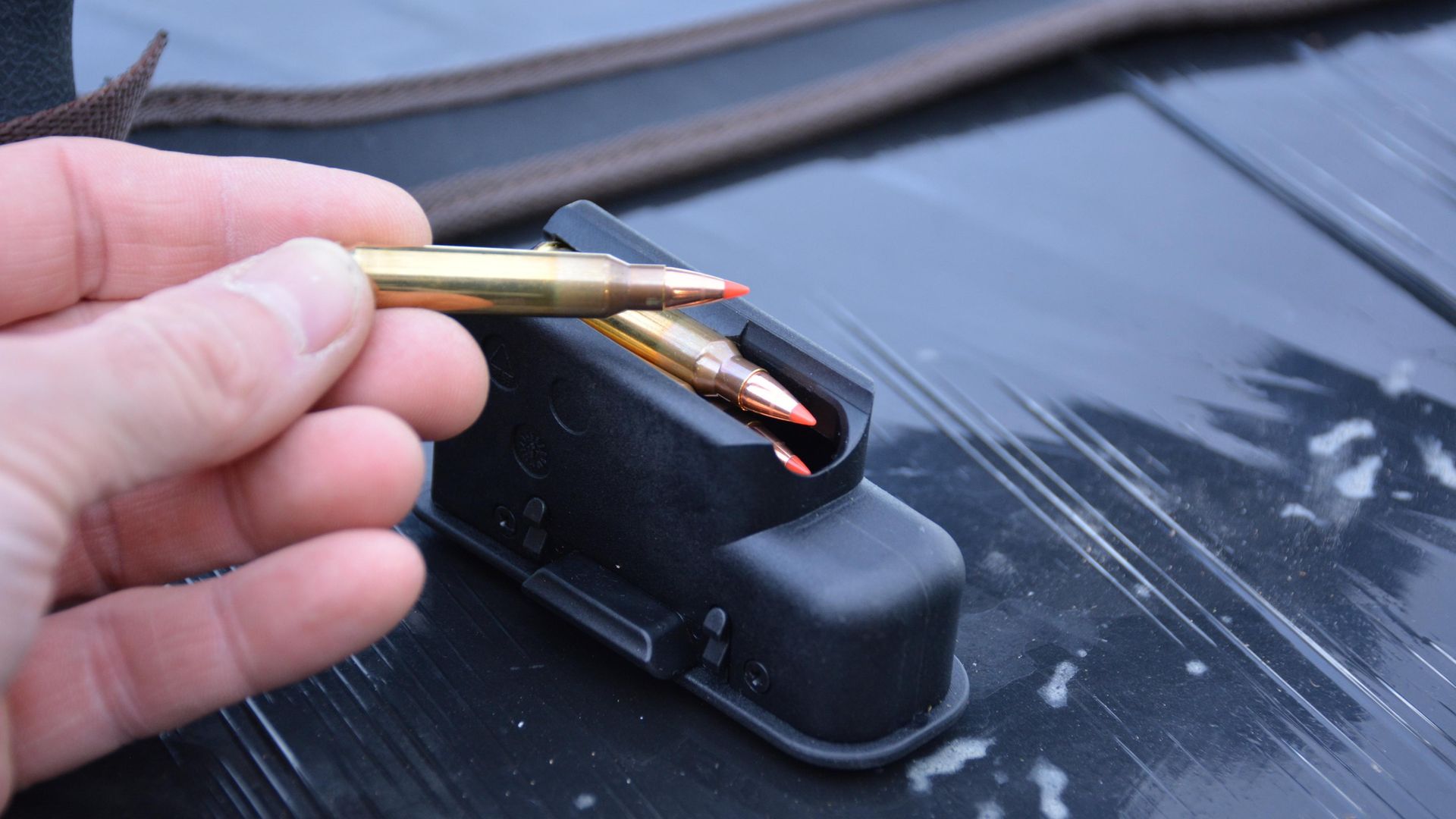 credit: Chris Parkin
credit: Chris Parkin
Ammo performance
Ammo | Av. muzzle
velocity
(fps) | 3-shot
group @
100m
(mm) |
Hornady
Varmint
55gr
Express | 3041 | 15.8 |
Hornady
55gr
Soft Point | 3074 | 13.5 |
Hornady
40gr V-Max
Handload | 3321 | 10.4 |
Sierra
50gr
Handload | 3174 | 16.1 |
Hornady
55gr V-Max
Handload | 3076 | 9.0 |
Remington
50gr
Accutip | 3264 | 11.1 |
 credit: Chris Parkin
credit: Chris Parkin
Tech specs
Calibres: .222 Rem., .223 Rem., .243 Win., .308 Win., 7mm-08 Rem., 7×64, .270 Win., .30-06 Spr., .25-06 Rem., 6,5×55 SE, 8×57 JS, 9,3×62
Overall-Length: 1.045 mm, 41″
Barrel-Length: 508 mm, 20″
Weight: 3.3 Kg, 7.3 lbs
Magazine: Detachable Synthetic Magazine holds 4
Trigger: Single Stage Here, 2-Stage Trigger / Forward Set Trigger / Double Set Options
Safety: 3 Position Safety, Trigger Safety, Bolt Handle And Firing Pin Lock
Stock: Synthetic Stock with polymer Inlays and Aluminium Bedding Block
Also included: A quality manual
True left hand version is available
RRP: £1706.99
Contact: Sportsman Gun Centre
Also supplied: Warne mounts, Nightforce scope, Wildcat Moderator and PARD Night Vision equipment
Also used
Hornady Ammunition and bullets
www.edgarbrothers.com
Magtech Primers/Lapua Brass
www.vikingshoot.com
Vihtavuori Powder
www.hannamsreloading.co.uk
Sierra Bullets
www.henrykrank.com
Remington ammunition
www.raytrade.co.uk